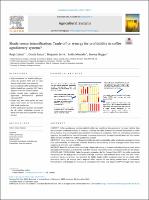Mostrar el registro sencillo del ítem
Shade versus intensification: Trade-off or synergy for profitability in coffee agroforestry systems?
| dc.contributor.author | Lanza, Gracia | |
| dc.contributor.author | Mercado, Leida | |
| dc.date.accessioned | 2025-05-14T20:50:32Z | |
| dc.date.available | 2025-05-14T20:50:32Z | |
| dc.date.issued | 2023-12-11 | |
| dc.identifier.uri | https://repositorio.catie.ac.cr/handle/11554/12811 | |
| dc.description.abstract | This study assesses the economic viability of different coffee production strategies in Costa Rica and Guatemala, comparing intensive systems with shaded agroforestry approaches. Using a typology based on levels of intensification and sustainability, the authors applied a stochastic cash flow model based on ten years of farm-level survey data, including information on costs, prices, and yields. Results indicate that high-productivity systems—with significant investment and moderate shade levels—achieve the highest Net Present Value (NPV) under future coffee price scenarios. Among low-investment systems, those with high shade cover yield a higher (and positive) NPV than low-shade systems, which on average produce negative returns despite similar investment levels. Diversification, particularly with high-value export avocados, marginally improves NPV, while other forms of diversification have limited economic impact. Although high-productivity systems incur greater production costs, they generally offer higher probabilities of achieving positive net income and living wages, except in cases of severe price drops (e.g., a 50% decline in coffee prices). Conversely, a 50% increase in coffee prices would be necessary for all farmers to achieve positive net cash income and, in the case of intensive systems, approach a living wage threshold. The study concludes that high-investment, high-productivity coffee systems are compatible with shaded agroforestry and are more likely to ensure economic success under most market conditions. For farmers with limited capacity to invest, high-shade systems offer more stable and positive returns across a wider range of price scenarios than low-shade alternatives. | es_ES |
| dc.format.extent | 18 páginas | es_ES |
| dc.language.iso | en | es_ES |
| dc.publisher | Elsevier | es_ES |
| dc.relation.ispartof | Agricultural Systems | es_ES |
| dc.relation.uri | https://doi.org/10.1016/j.agsy.2023.103814 | es_ES |
| dc.subject | Coffee agroforestry | es_ES |
| dc.subject | Ecosystem services | es_ES |
| dc.subject | Shaded coffee | es_ES |
| dc.subject | Sustainable agricultural intensification | es_ES |
| dc.subject | Probabilistic cash-flow analysis | es_ES |
| dc.subject.other | Sede Central | es_ES |
| dc.title | Shade versus intensification: Trade-off or synergy for profitability in coffee agroforestry systems? | es_ES |
| dc.type | Artículo | es_ES |
| dc.identifier.status | openAccess | es_ES |
| dc.subject.sdg | ODS 12 - Producción y consumo responsables | es_ES |


